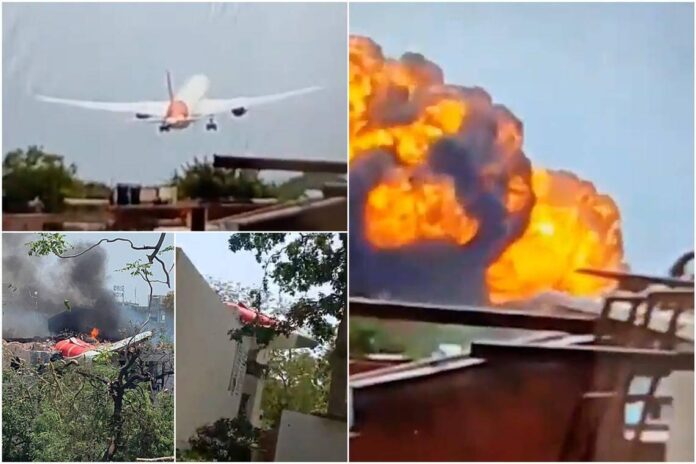Air India Flight 171 had been airborne for just 11 seconds when a routine take-off suddenly became an irrecoverable disaster.
Captain Sumeet Sabharwal radioed the ground to say: “Mayday…no thrust, losing power, unable to lift!”
Over the next 19 seconds the Boeing Dreamliner steadily lost altitude and drifted to the ground before crashing into buildings, killing almost everyone on board and dozens on the ground as air traffic controllers watched helplessly.
Exactly what caused flight 171 to fall back to Earth will be the subject of an investigation that might take months, with birdstrikes and mechanical failure among the possibilities that will be looked into.
On Thursday night the confirmed death toll was 241, with only one passenger – a 40-year-old Briton – known to have survived the tragedy.
The video footage shows it appearing to suffer a catastrophic loss of lift as it falls to the ground, still in its nose-up take-off angle, unable to stay airborne. The Boeing 787-8 Dreamliner never reached the right rate of climb during its short trajectory.
In those fateful moments, the highly experienced pilot and Clive Kundar, his co-pilot, alerted ground control to the fact they were in terrible trouble, but after reaching a maximum altitude of barely 400ft all contact with the aircraft was lost.
Incredibly, one passenger survived the crash. Vishwash Kumar Ramesh, a 40-year-old Londoner, who was in seat 11A and is now in hospital.
Vishwash Kumar Ramesh, a British national, survived the crash
Moments earlier, the departure lounge of Ahmedabad airport had been the usual mix of excitement and anticipation as passengers returned home from holidays, headed off on adventures or looked forward to family reunions ahead of their scheduled 9hr 50min non-stop flight to London Gatwick.
They included married couple Fiongal and Jamie Greenlaw-Meek, from London, who passed the time by recording an Instagram video in which Fiongal smiled and rolled his eyes as Jamie said they were about to board a “10 hour flight back to England”.
Also waiting in the lounge was Adnan Master, a 30-year-old east Londoner who had been visiting relatives in India, the Lalgi family, from Wembley, and Raxa Modha, from Northamptonshire. Others were flying home to Leicester.
Local passengers at Sardar Vallabhbhai Patel International Airport had noticed that at least one VIP was among them – Vijay Rupani, the former chief minister of the Gujarat region, in which the airport is situated.
Their Air India aircraft was being cleaned, fuelled and readied for boarding. The passengers may have been reassured by the fact that it was a Boeing 787-8 Dreamliner, a type of jet that had never been involved in a fatal accident.
The weather was ideal for flying: sunny and dry, with an air temperature approaching 40C.
The Boeing 787-8 Dreamliner appeared to suffer a catastrophic loss of power as it fell to the ground, still in its nose-up take-off angle
Everything appeared normal as the passengers boarded and the aircraft taxied towards runway 23 shortly after 1.30pm local time (9am BST).
On board were 230 passengers, including 53 Britons, 169 Indians, seven Portuguese and one Canadian, as well as 12 crew. Eleven of the passengers were children.
In the cockpit, Captain Sumeet Sabharwal and First Officer Clive Kundar, who boasted more than 9,000 hours of flying time between them, increased power and comfortably reached takeoff speed, clocking 174 knots according to data recorded on the ground.
What happened next was captured on CCTV footage that will form crucial evidence for air crash investigators.



